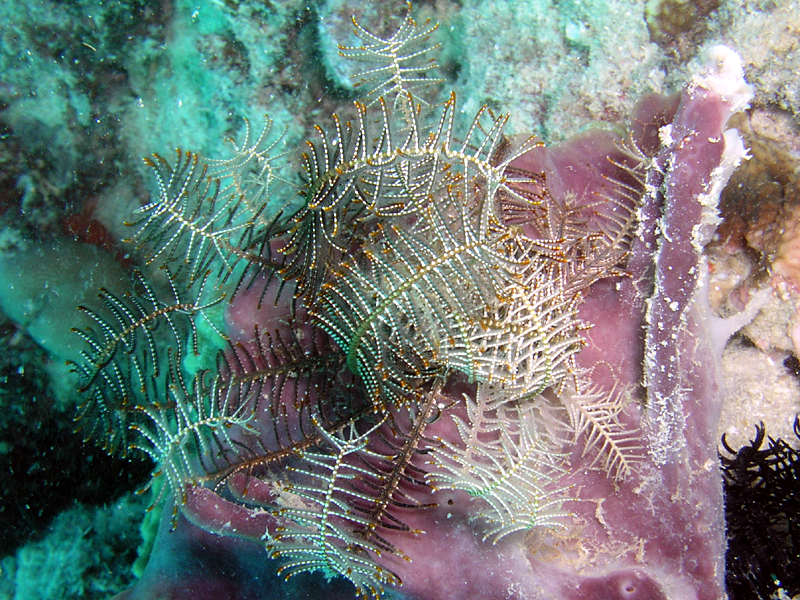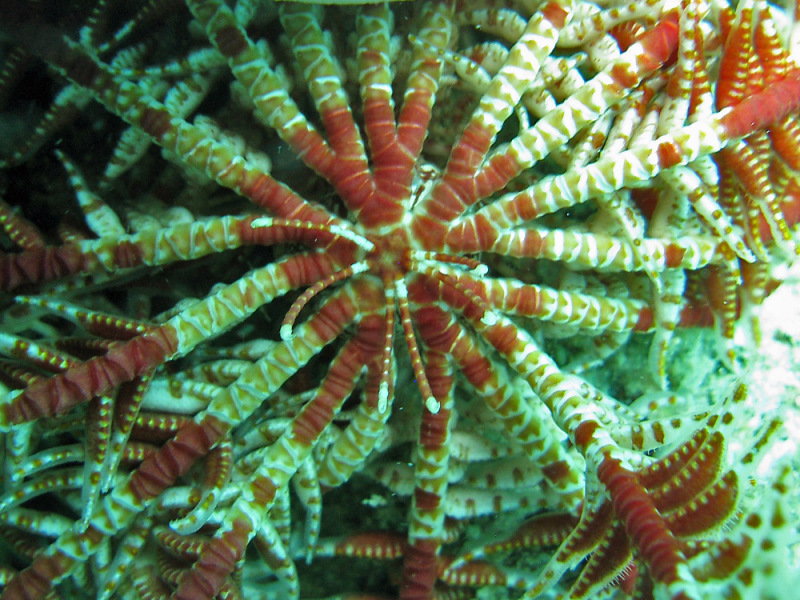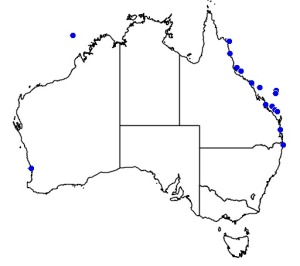
©Lyle Vail and Anne Hoggett: The irridescent blue colour form of Clarkcomanthus comanthipinnus at Lizard Island.

©Lyle Vail and Anne Hoggett: The pale brown colour form of Clarkcomanthus comanthipinnus at Lizard Island

©Anne Hoggett: Underside of the most cryptic form Clarkcomanthus comanthipinnus showing concentric banding pattern and few weak cirri.
Colours
Distinguishing features
Featherstars in the family Comatulidae are distinguised from all others by having terminal segments of the oral pinnules modified to form a comb. Comatulids also have a distinctive "feel" due to well developed hooks on most pinnules that cause them to cling like velcro.
Clarkcomanthus comanthipinnus is a small crinoid with up to 25 quite stiff, slender arms and a few cirri. Some individuals expose a few arms during the day but others remain completely concealed. The combed pinnules have a sharp tips but that is not a useful field character.
Colour pattern varies enormously over its wide geographic range.
At Lizard Island, specimens that expose arms during the day have two colour forms.
1) irridescent blue or blue/green brachials with a longitudinal row of yellow or pale spots on the underside; black pinnules with a row of yellow spots and often orange pinnule tips.
2) Pale brown with an indistinct pale midline on the lower arm surface. This form was previously known as Clarkcomanthus exilis.
Specimens that remain completely concealed under rubble during the day have a different colour pattern:
3) Usually bright red with white concentric banding on the lower surface. This form was also previously known as Clarkcomanthus exilis.
Size
- Size data has not been obtained.
Depth range
- Depth range data is not yet available.
Synonyms
Distribution
Distribution and habitat preferences
Central body mass always hidden, usually found with a few arms protruding from a crevice during the day.
Found most commonly on exposed reef slopes from North Point around the northern, eastern and southern side of the Lizard Island group.
Noted above.
Found most commonly in the lagoon and on the western side of the island group.
Web resources
References
References that assist with identification
- Rowe, F.W.E., A.K. Hoggett, R.A. Birtles and L.L. Vail (1986). Revision of some comasterid general from Australia (Echinodermata: Crinoidea), with descriptions of two new genera and nine new species, Zoological Journal of the Linnean Society, 86: 197-277. LIRS catalog number 198.
- Summers, M. M., C.G. Messing and G.W. Rouse (2014). Phylogeny of Comatulidae (Echinodermata: Crinoidea: Comatulida): A new classification and an assessment of morphological characters for crinoid taxonomy, Molecular Phylogenetics and Evolution, 80: 319-339. LIRS catalog number 1813.
Other references
- Lanterbecq, D., G.W. Rouse and I. Eeckhaut (2009). Evidence for cospeciation events in the host-symbiont system involving crinoids (Echinodermata) and their obligate associates, the myzostomids (Myzostomida, Annelida), Molecular Phylogenetics and Evolution, doi: 10.1016: jymev20090811. LIRS catalog number 1274.
- View all references


